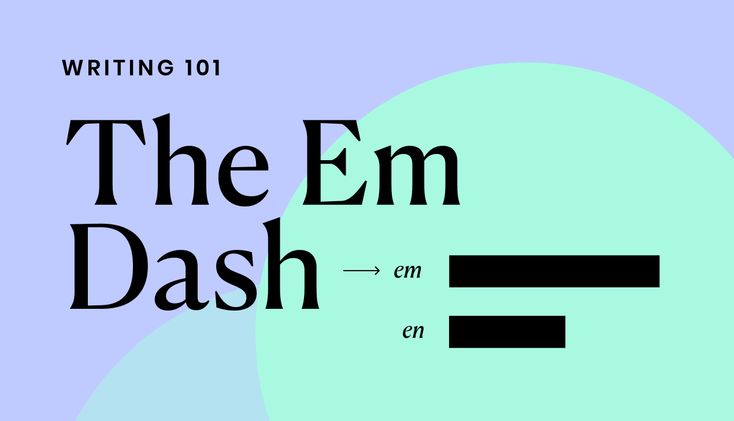Em dashes are versatile punctuation marks that can add a dash of flair to your writing. Whether you’re using a Mac or a Windows PC, knowing how to type an em dash can greatly enhance the clarity and style of your writing. This guide will walk you through the steps for typing an em dash on both operating systems and explain when to use em dashes versus en dashes.
How to Type an Em Dash on a Mac
Typing an em dash on a Mac is straightforward and can be done using simple keyboard shortcuts. Here’s how you can do it:
Method 1: Using Keyboard Shortcuts
- Direct Shortcut: Press Option (⌥) + Shift + Hyphen (-). This will instantly insert an em dash (—) into your text.
- Example: “The meeting—scheduled for 10 AM—was postponed.”
Method 2: Using the Character Viewer
- Open Character Viewer: Press Control (⌃) + Command (⌘) + Space to open the Character Viewer.
- Search for Em Dash: In the search bar, type “em dash.”
- Insert Em Dash: Click on the em dash symbol to insert it into your document.
Method 3: Custom Shortcuts in TextEdit or Word
- Text Replacement: You can set up a text replacement in System Preferences.
- Go to System Preferences > Keyboard > Text.
- Click the + button to add a new shortcut.
- In the Replace field, type a shortcut like
--. - In the With field, paste the em dash (—).
- Now, whenever you type
--, it will automatically change to an em dash.
Benefits of Using an Em Dash on a Mac
- Quick and Easy: Keyboard shortcuts save time and improve efficiency.
- Professional Appearance: Using the correct punctuation mark adds a professional touch to your documents.
- Versatility: Em dashes can be used to create emphasis, insert additional information, or replace commas, parentheses, or colons.
How to Type an Em Dash on Windows
Windows offers several ways to type an em dash, catering to different preferences and software.
Method 1: Using Keyboard Shortcuts
- Num Lock: Ensure that Num Lock is enabled on your keyboard.
- Alt Code: Hold down the Alt key and type 0151 on the numeric keypad.
- Example: “The project timeline—spanning six months—was ambitious.”
Method 2: Using Character Map
- Open Character Map: Search for “Character Map” in the Start menu and open it.
- Find the Em Dash: Scroll through the list or search for “em dash.”
- Copy and Paste: Select the em dash, click “Select,” then “Copy.” Paste it into your document where needed.
Method 3: AutoCorrect in Microsoft Word
- Open Word: Launch Microsoft Word.
- AutoCorrect Options: Go to File > Options > Proofing > AutoCorrect Options.
- Replace Text: In the “Replace” field, type a shortcut like
--. - With Field: In the “With” field, paste the em dash (—).
- Add: Click “Add” and then “OK.” Now, typing
--will automatically convert to an em dash.
Method 4: Using Unicode
- Unicode Input: In applications that support Unicode input, type 2014 and then press Alt + X. This will convert the code to an em dash.
- Example: Typing
2014followed byAlt + Xin a supported app will give you an em dash (—).
Benefits of Using an Em Dash on Windows
- Accessibility: Multiple methods ensure accessibility regardless of your software setup.
- Professional Documentation: Em dashes enhance the readability and professionalism of your documents.
- Flexibility: Use different methods depending on your workflow and preferences.
Em Dash vs. En Dash: When to Use Each Symbol
Understanding when to use an em dash versus an en dash is crucial for clear and effective writing. Here’s a breakdown of each symbol and their uses:
Em Dash (—)
The em dash is the longer of the two dashes. It’s roughly the width of an uppercase “M” and is used in various contexts:
- Indicating a Break in Thought: Em dashes can indicate a pause or break in thought, adding emphasis or additional information.
- Example: “The CEO’s decision—though controversial—was ultimately beneficial.”
- Replacing Parentheses: Em dashes can replace parentheses for added emphasis.
- Example: “The new policy—implemented last month—has already shown positive results.”
- Setting Off Appositives: Em dashes can be used to set off appositives that contain commas.
- Example: “The conference attendees—scientists, researchers, and engineers—were impressed by the keynote speaker.”
En Dash (–)
The en dash is shorter than the em dash but longer than a hyphen. It’s roughly the width of an uppercase “N” and is used for different purposes:
- Ranges: En dashes indicate a range of values, such as dates, times, or numbers.
- Example: “The office will be closed from December 24–26.”
- Connecting Values: En dashes connect values that have a relationship, such as scores or directions.
- Example: “The train route is the New York–Boston line.”
- Complex Compound Adjectives: En dashes can be used in complex compound adjectives where one part is already hyphenated or consists of multiple words.
- Example: “The post–World War II era saw significant changes.”
Visual Differences and Usage Rules
- Visual Appearance: The em dash (—) is longer than the en dash (–), making it easy to distinguish visually.
- Keyboard Shortcuts: On a Mac, type an en dash with Option (⌥) + Hyphen (-). On Windows, use Alt + 0150.
- Contextual Clarity: Use em dashes for breaks and emphasis; use en dashes for ranges and connections.
Best Practices
- Consistency: Maintain consistency in using em dashes and en dashes according to their respective rules.
- Readability: Ensure that the use of dashes enhances readability and does not confuse the reader.
- Professional Writing: Adhering to proper usage of em dashes and en dashes reflects a strong command of written language and professionalism.
Conclusion
Knowing how to type an em dash on both Mac and Windows and understanding when to use it versus an en dash, can greatly improve the quality and clarity of your writing. Em dashes are versatile punctuation marks that can add emphasis, indicate breaks in thought, and replace other punctuation marks for a more polished and professional look. Whether you’re typing an important document, drafting an email, or crafting content for publication, mastering these dashes will enhance your writing skills and ensure your text is both engaging and easy to read.
Frequently Asked Questions:
- What is the difference between an em dash and an en dash?
Answer: The em dash (—) is longer than the en dash (–). The em dash is used to indicate a break in thought, add emphasis, or replace parentheses. It’s roughly the width of an uppercase “M.” The en dash, which is the width of an uppercase “N,” is used for ranges of numbers, dates, and times, as well as to connect values like scores and complex compound adjectives.
- How can I type an em dash on a Mac using a keyboard shortcut?
Answer: To type an em dash on a Mac, use the keyboard shortcut Option (⌥) + Shift + Hyphen (-). This will instantly insert an em dash (—) into your text.
- What are the different methods to type an em dash on Windows?
Answer: There are several methods to type an em dash on Windows:
- Alt Code Method: Ensure Num Lock is on, hold down the Alt key, and type 0151 on the numeric keypad.
- Character Map Method: Open the Character Map from the Start menu, find the em dash, and copy-paste it into your document.
- AutoCorrect in Microsoft Word: Set up AutoCorrect to replace
--with an em dash (—). - Unicode Input: Type 2014 and press Alt + X in applications that support Unicode input.
- When should I use an em dash instead of a comma or parentheses?
Answer: Use an em dash instead of a comma or parentheses when you want to add emphasis or indicate a stronger break in the sentence. Em dashes are suitable for setting off appositives with commas, inserting additional information, or creating a pause for dramatic effect. They provide a more noticeable separation than commas and are more informal than parentheses. For example, “The new policy—implemented last month—has already shown positive results.”
- How Does Automated Scheduling Save Time and Boost Engagement? - April 16, 2025
- 21 Delicious High Protein Foods - May 31, 2024
- Black Seed Oil: Health and Beauty Benefits - May 30, 2024




